Page 4171 of 4323
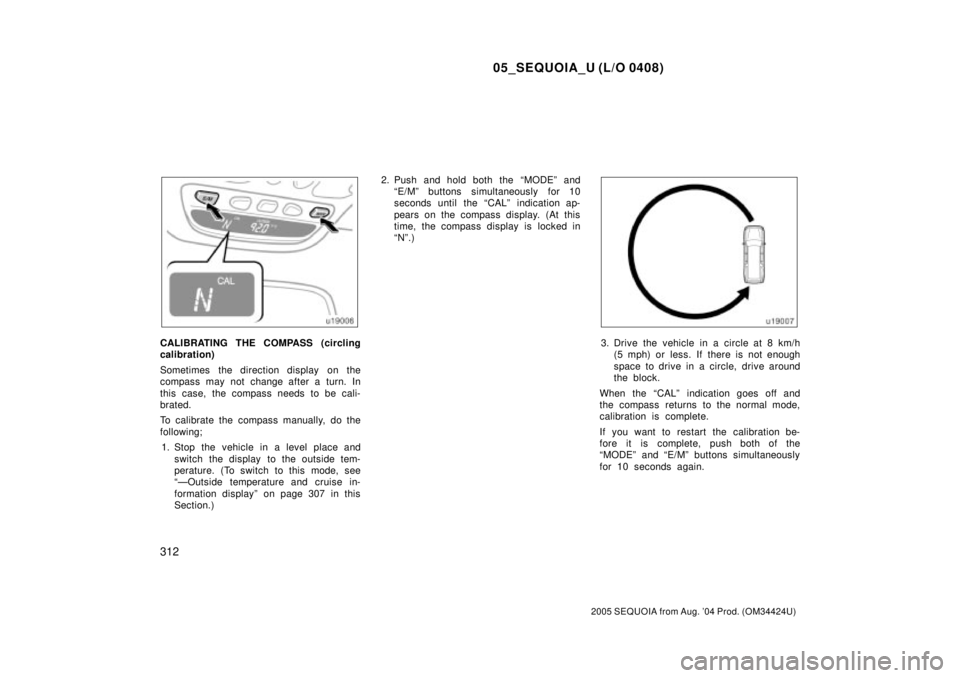
05_SEQUOIA_U (L/O 0408)
312
2005 SEQUOIA from Aug. '04 Prod. (OM34424U)
CALIBRATING THE COMPASS (circling
calibration)
Sometimes the direction display on the
compass may not change after a turn. In
this case, the compass needs to be cali-
brated.
To calibrate the compass manually, do the
following;
1. Stop the vehicle in a level place and
switch the display to the outside tem-
perature. (To switch to this mode, see
ªÐOutside temperature and cruise in-
formation displayº on page 307 in this
Section.)2. Push and hold both the ªMODEº and
ªE/Mº buttons simultaneously for 10
seconds until the ªCALº indication ap-
pears on the compass display. (At this
time, the compass display is locked in
ªNº.)3. Drive the vehicle in a circle at 8 km/h
(5 mph) or less. If there is not enough
space to drive in a circle, drive around
the block.
When the ªCALº indication goes off and
the compass returns to the normal mode,
calibration is complete.
If you want to restart the calibration be-
fore it is complete, push both of the
ªMODEº and ªE/Mº buttons simultaneously
for 10 seconds again.
Page 4188 of 4323
05_SEQUOIA_U (L/O 0408)
329
2005 SEQUOIA from Aug. '04 Prod. (OM34424U)
Type A (instrument panel)
Type B (front side of rear console box)
Type C (rear side of rear console box)
Type D (rear side trim)
To secure your luggage, use the tie±
down hooks as shown above.
See ªÐStowage precautionsº on page 356
in Section 2 for precautions when loading
luggage.
CAUTION
To avoid personal injury, keep the tie±
down hooks folded in place on the
floor when not in use.
NOTICE
Do not use the seat anchors instead
of the tie±down hooks.
Tie±down hooks
Page 4190 of 4323
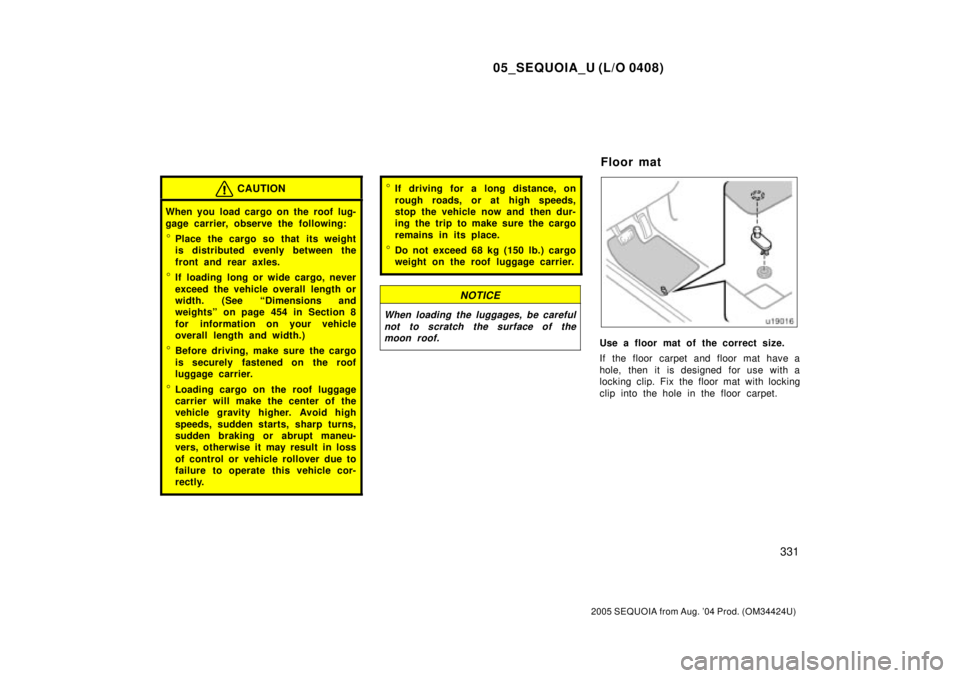
05_SEQUOIA_U (L/O 0408)
331
2005 SEQUOIA from Aug. '04 Prod. (OM34424U)
CAUTION
When you load cargo on the roof lug-
gage carrier, observe the following:
�Place the cargo so that its weight
is distributed evenly between the
front and rear axles.
�If loading long or wide cargo, never
exceed the vehicle overall length or
width. (See ªDimensions and
weightsº on page 454 in Section 8
for information on your vehicle
overall length and width.)
�Before driving, make sure the cargo
is securely fastened on the roof
luggage carrier.
�Loading cargo on the roof luggage
carrier will make the center of the
vehicle gravity higher. Avoid high
speeds, sudden starts, sharp turns,
sudden braking or abrupt maneu-
vers, otherwise it may result in loss
of control or vehicle rollover due to
failure to operate this vehicle cor-
rectly.
�If driving for a long distance, on
rough roads, or at high speeds,
stop the vehicle now and then dur-
ing the trip to make sure the cargo
remains in its place.
�Do not exceed 68 kg (150 lb.) cargo
weight on the roof luggage carrier.
NOTICE
When loading the luggages, be careful
not to scratch the surface of the
moon roof.
Use a floor mat of the correct size.
If the floor carpet and floor mat have a
hole, then it is designed for use with a
locking clip. Fix the floor mat with locking
clip into the hole in the floor carpet.
Floor mat
Page 4199 of 4323

05_SEQUOIA_U (L/O 0408)
340
2005 SEQUOIA from Aug. '04 Prod. (OM34424U)
�Oil is also used to lubricate the stems
of the intake valves. Some of this oil
is sucked into the combustion chamber
together with the intake air and is
burned along with the fuel. High tem-
perature exhaust gases also burn the
oil used to lubricate the exhaust valve
stems.
The amount of engine oil consumed de-
pends on the viscosity of the oil, the
quality of the oil and the conditions the
vehicle is driven under.
More oil is consumed by high±speed driv-
ing and frequent acceleration and decel-
eration.
A new engine consumes more oil, since
its pistons, piston rings and cylinder walls
have not become conditioned.
Oil consumption: Max. 1.0 L per 1000
km (1.1 qt./600 miles, 0.9 lmp. qt./600
miles)When judging the amount of oil con-
sumption, note that the oil may become
diluted and make it difficult to judge
the true level accurately.
As an example, if a vehicle is used for
repeated short trips, and consumes a nor-
mal amount of oil, the dipstick may not
show any drop in the oil level at all, even
after 1000 km (600 miles) or more. This
is because the oil is gradually becoming
diluted with fuel or moisture, making it
appear that the oil level has not changed.
The diluting ingredients evaporate out
when the vehicle is then driven at high
speeds, as on an expressway, making it
appear that oil is excessively consumed
after driving at high speeds.
IMPORTANCE OF ENGINE OIL LEVEL
CHECK
One of the most important points in prop-
er vehicle maintenance is to keep the en-
gine oil at the optimum level so that oil
function will not be impaired. Therefore, it
is essential that the oil level be checked
regularly. Toyota recommends that the oil
level be checked every time you refuel
the vehicle.NOTICE
Failure to check the oil level regularly
could lead to serious engine trouble
due to insufficient oil.
For detailed information on oil level check,
see ªChecking the engine oil levelº on
page 424 in Section 7±2.
Page 4203 of 4323
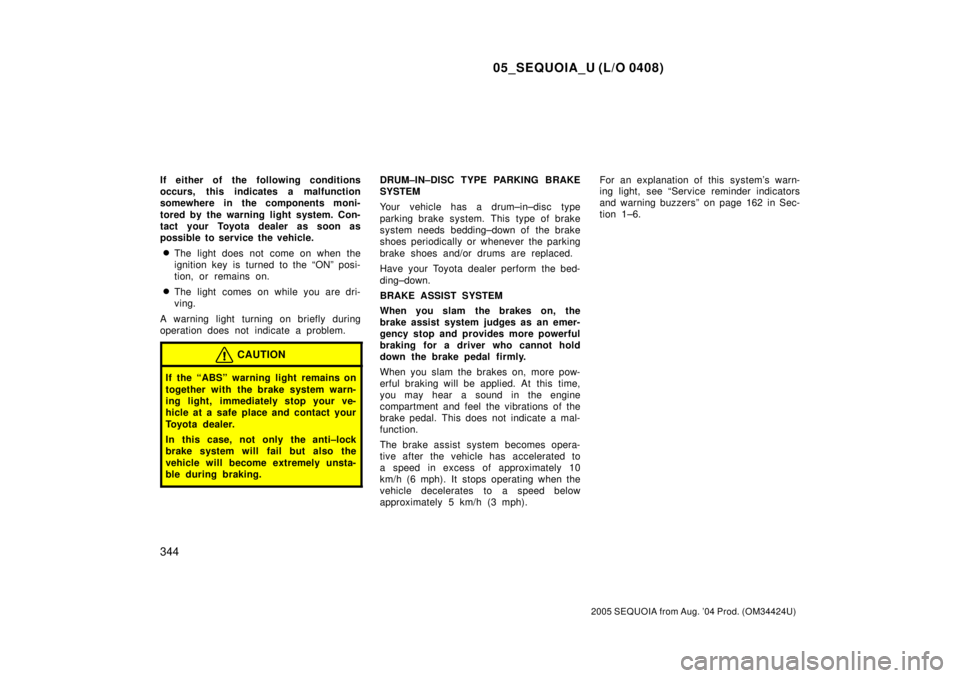
05_SEQUOIA_U (L/O 0408)
344
2005 SEQUOIA from Aug. '04 Prod. (OM34424U)
If either of the following conditions
occurs, this indicates a malfunction
somewhere in the components moni-
tored by the warning light system. Con-
tact your Toyota dealer as soon as
possible to service the vehicle.
�The light does not come on when the
ignition key is turned to the ªONº posi-
tion, or remains on.
�The light comes on while you are dri-
ving.
A warning light turning on briefly during
operation does not indicate a problem.
CAUTION
If the ªABSº warning light remains on
together with the brake system warn-
ing light, immediately stop your ve-
hicle at a safe place and contact your
Toyota dealer.
In this case, not only the anti±lock
brake system will fail but also the
vehicle will become extremely unsta-
ble during braking.
DRUM±IN±DISC TYPE PARKING BRAKE
SYSTEM
Your vehicle has a drum±in±disc type
parking brake system. This type of brake
system needs bedding±down of the brake
shoes periodically or whenever the parking
brake shoes and/or drums are replaced.
Have your Toyota dealer perform the bed-
ding±down.
BRAKE ASSIST SYSTEM
When you slam the brakes on, the
brake assist system judges as an emer-
gency stop and provides more powerful
braking for a driver who cannot hold
down the brake pedal firmly.
When you slam the brakes on, more pow-
erful braking will be applied. At this time,
you may hear a sound in the engine
compartment and feel the vibrations of the
brake pedal. This does not indicate a mal-
function.
The brake assist system becomes opera-
tive after the vehicle has accelerated to
a speed in excess of approximately 10
km/h (6 mph). It stops operating when the
vehicle decelerates to a speed below
approximately 5 km/h (3 mph).For an explanation of this system's warn-
ing light, see ªService reminder indicators
and warning buzzersº on page 162 in Sec-
tion 1±6.
Page 4206 of 4323
05_SEQUOIA_U (L/O 0408)
347
2005 SEQUOIA from Aug. '04 Prod. (OM34424U)
This illustration indicates typical tire
symbols.
1. Tire sizeÐF or det ails, see ªÐ Ti re
sizeº on page 349.
2. DOT and Tire Identification
Number (TIN)ÐFor details, see
ªÐDOT and Tire Identification
Number (TIN)º on page 348.
3. Uniform tire quality gradingÐ
For details, see ªÐUniform tire
quality gradingº on page 350.
4. The location of the tread wear
indicatorsÐFor details, see
ªChecking and replacing tiresº on
page 432.
5. Ti re pl y co mp o si t i o n an d mat e-
rialsÐPlies mean a layer of rub-
ber±coated parallel cords. Cords
mean the strands forming the plies
in the tire.
6. Radial tires or bias±ply tiresÐA
radial tire has ªRADIALº on the
sidewall. A tire not marked with
ªRADIALº is a bias±ply tire.
Tire informationÐ
ÐTire symbols
Page 4207 of 4323
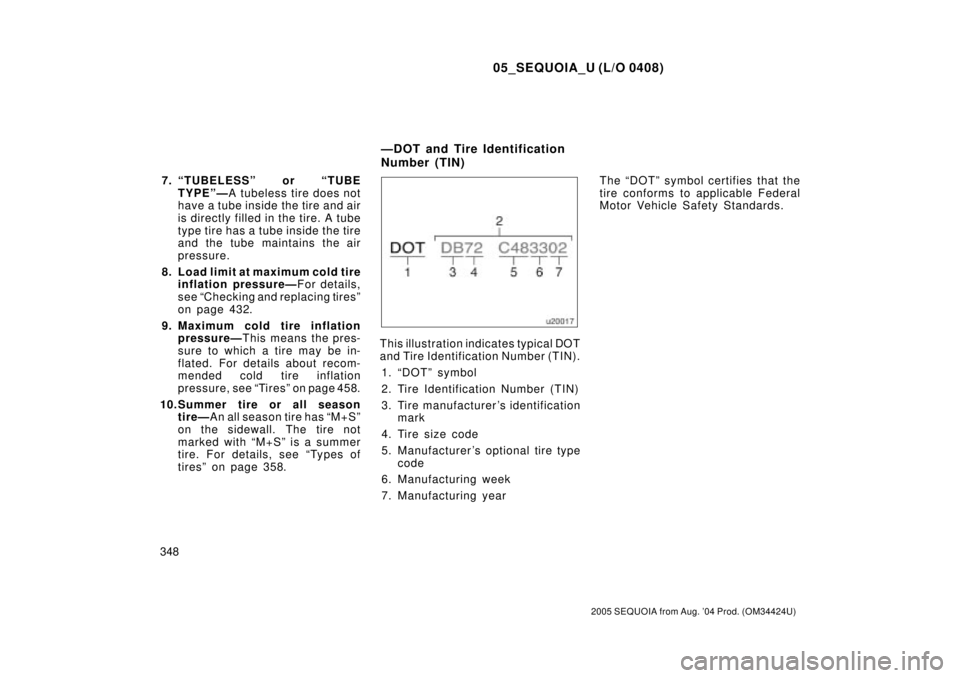
05_SEQUOIA_U (L/O 0408)
348
2005 SEQUOIA from Aug. '04 Prod. (OM34424U)
7. ªTUBELESSº or ªTUBE
TYPEºÐA tubeless tire does not
have a tube inside the tire and air
is directly filled in the tire. A tube
type tire has a tube inside the tire
and the tube maintains the air
pressure.
8. Load limit at maximum cold tire
inflation pressureÐFor details,
see ªChecking and replacing tiresº
on page 432.
9. Maximum cold tire inflation
pressureÐThis means the pres-
sure to which a tire may be in-
flated. For details about recom-
mended cold tire inflation
pressure, see ªTiresº on page 458.
10.Summer tire or all season
tireÐAn all season tire has ªM+Sº
on the sidewall. The tire not
marked with ªM+Sº is a summer
tire. For details, see ªTypes of
tiresº on page 358.
This illustration indicates typical DOT
and Tire Identification Number (TIN).
1. ªDOTº symbol
2. Tire Identification Number (TIN)
3. Tire manufacturer 's identification
mark
4. Tire size code
5. Manufacturer 's optional tire type
code
6. Manufacturing week
7. Manufacturing yearThe ªDOTº symbol certifies that the
tire conforms to applicable Federal
Motor Vehicle Safety Standards.
ÐDOT and Tire Identification
Number (TIN)
Page 4216 of 4323
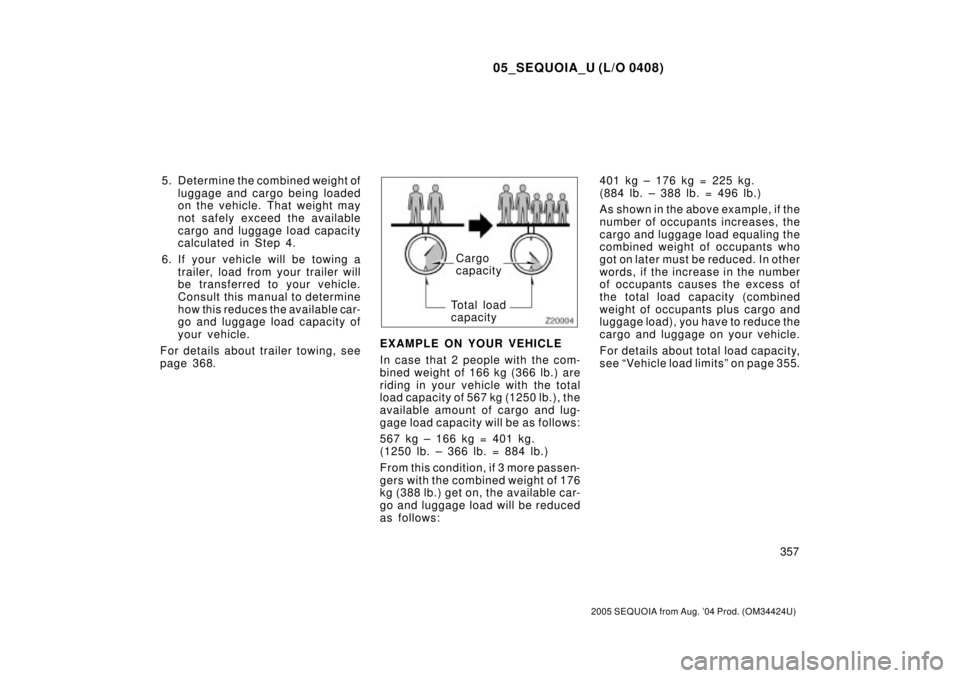
05_SEQUOIA_U (L/O 0408)
357
2005 SEQUOIA from Aug. '04 Prod. (OM34424U)
5. Determine the combined weight of
luggage and cargo being loaded
on the vehicle. That weight may
not safely exceed the available
cargo and luggage load capacity
calculated in Step 4.
6. If your vehicle will be towing a
trailer, load from your trailer will
be transferred to your vehicle.
Consult this manual to determine
how this reduces the available car-
go and luggage load capacity of
your vehicle.
For details about trailer towing, see
page 368.
Cargo
capacity
Total load
capacity
EXAMPLE ON YOUR VEHICLE
In case that 2 people with the com-
bined weight of 166 kg (366 lb.) are
riding in your vehicle with the total
load capacity of 567 kg (1250 lb.), the
available amount of cargo and lug-
gage load capacity will be as follows:
567 kg ± 166 kg = 401 kg.
(1250 lb. ± 366 lb. = 884 lb.)
From this condition, if 3 more passen-
gers with the combined weight of 176
kg (388 lb.) get on, the available car-
go and luggage load will be reduced
as follows:401 kg ± 176 kg = 225 kg.
( 884 lb. ± 388 lb. = 496 lb. )
As shown in the above example, if the
number of occupants increases, the
cargo and luggage load equaling the
combined weight of occupants who
got on later must be reduced. In other
words, if the increase in the number
of occupants causes the excess of
the total load capacity (combined
weight of occupants plus cargo and
luggage load), you have to reduce the
cargo and luggage on your vehicle.
For details about total load capacity,
see ªVehicle load limitsº on page 355.